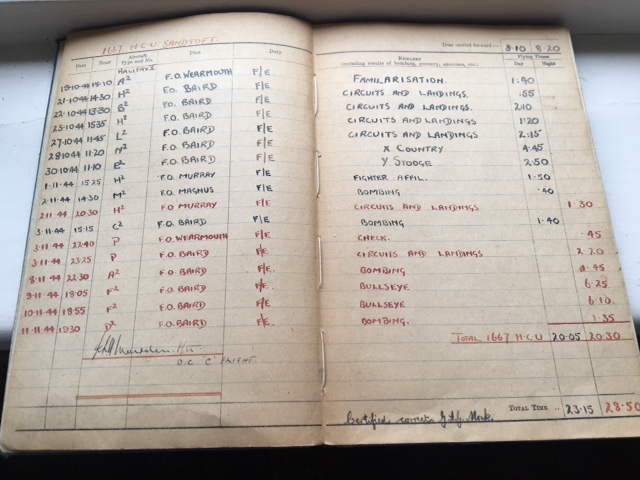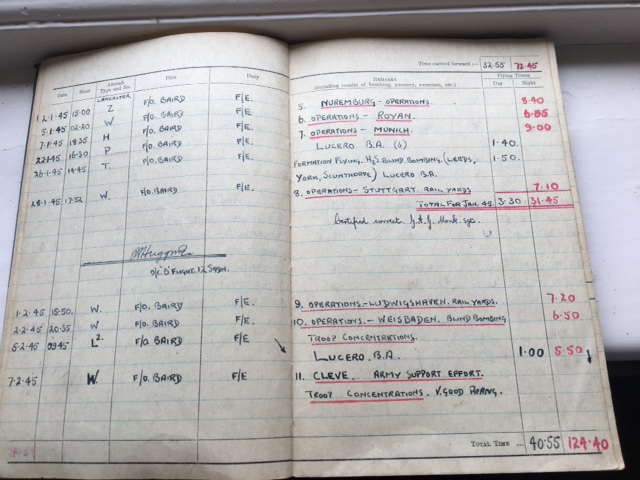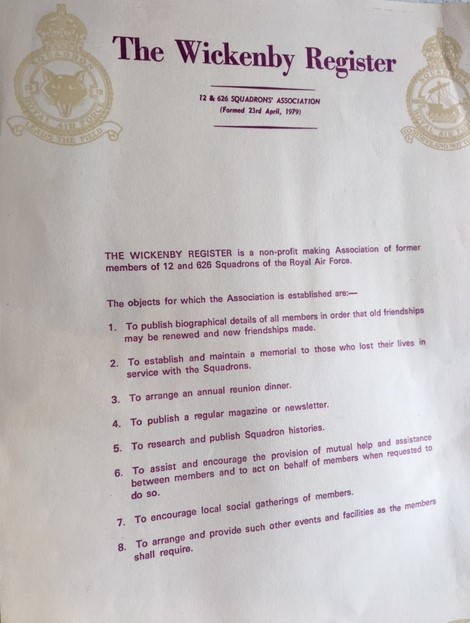Geoffrey Monk served as a Flight Engineer on No 12 Sqn at RAF Wickenby 1944-45.
Many thanks to Linda Baillie, daughter of Geoffrey Monk, for providing this material. Linda lives just a few miles from RAF Brize Norton and was introduced to the Association through one of our current members – John Bean.
Whilst writing this article I wanted to add a few links explaining the historical backdrop to Geoffrey’s career. I was astonished to discover a recorded interview with Geoffrey’s skipper in which he recounts a number of their most notable operations – including the wall of flack. Webmaster – July 2020.

Early Years
Geoffrey Alfred Gordon Monk was born in Leeds on July 11th 1924 the only child of Harold & Sylvia Monk. His father fought in Ypres and Loos in First World War and also in East African Campaign immediately after leaving the Western Front.
Geoffrey attended Roundhay Grammar School, Leeds. He always had a passion for aircraft and flying, stemming from his love of model making and being taken up in a plane during an air show by his father at about the age of twelve.
He loved motor cross and, when too young to sign up for the war, was a messenger rider on his motor bike, riding over the moors without lights at night to deliver MOD messages from Leeds to Manchester & other destinations.
Always wanting to fly, he trained as an engineer so that he could join the RAF as soon as possible and take part in the war, with a shorter training than if he was to become a pilot. His apprenticeship in general engineering was interrupted by war service.
No 4 S of TT, RAF St Athan. Dec 1943 – Sep 1944.
Geoffrey joined the RAF on 27 December 1943 at 19 years of age. A mere 9 months later he graduated from No 4 School of Technical Training, St Athan, qualified as a flight engineer on the Lancaster Mk 1 & 3.






No 1667 Heavy Conversion Unit – RAF Sandtoft
Oct – Nov 1944
In October 1944 Geoffrey was posted to No 1667 Heavy Conversion Unit at RAF Sandtoft, Lincolnshire. Here he would join the crew that he would fly with for the remainder of the war and remain life-long friends.
Five of the Seven crew members were from the Royal Canadian Air Force. The skipper, Ernest Baird was only 21 years old; he would later go on to be awarded the Distinguished Flying Cross.

During an 8-week period at Sandtoft, the fledgling crew covered aircraft familiarisation, circuits and landings, bombing, fighter affiliation and bullseye exercises on the Handley Page Halifax Mk 5. A further 12 hours were then flown on the Lancaster Finishing School also at Sandtoft.


No 12 Sqn RAF Wickenby
Nov – Dec 1944
On 25 November 1944 Geoffrey and his crew were posted to No 12 Sqn RAF Wickenby Within a matter of weeks the crew were ready for operations. Geoffrey, now 20 years old, had recorded only 85 hours flying time when tasked with hist first operation over the Rhur.




Jan – Feb 1944




March 1945
On 11 March 1945 12 Sqn was tasked to attack Essen (Operation No 18). The total force of 1079 aircraft was the largest bomber force used during the war.

On Geoffrey’s 20th operation, laying mines in Oslo Fjord, his log book makes mention of being hit by flack.
The skipper, Ernest Baird, described many years later in a recorded interview the extent of the damage to the aircraft:
And our orders were, when we dropped our mines, you had to stay on a steady course for another 30 seconds. And in order to get another picture, because we had cameras to show exactly where it was, and these pictures would go to the [Royal] Navy intelligence and they could plot where those mines were, what would have landed and they would know where they were. And so we were supposed to stay nice and steady until we could get that last picture. Well, we were going along and suddenly, they started shooting anti-aircraft at us and we could see it in front of us. And we were flying right straight towards it and they had us charted, where they were going to putting these up.
And it works like a little sparklers you use at Christmas time or Halloween, you see these little sparklers, that’s when the aircraft shells come up and they’re predetermined height, they explode automatically and make a little flash of light and, and the shrapnel that would fly out from those would sometimes be red hot, you’d see this.
Anyway, we were sort of clenching our fists, flying into this and most of the crew didn’t see all of it but I could, and my flight engineer. But we flew right into where this flak was all coming up, doing what we were told to do. And halfway through this, we got a sudden bang, just sounded like we, and it shuddered the whole aircraft and I said, “Well, let’s get out of here,” we didn’t stay steady anymore and we did an evasive movement which got us away from the flak.
And we did a check, everything was okay and it wasn’t until we landed back at base afterwards, we found out, we didn’t find anything out the first night when we got in in the dark, couldn’t see anything, it wasn’t until the next morning, we went out and found out that the ground crew had taken the whole wingtip off of our plane. They had found that a shell had gone right through the wing without exploding. And a nice round hole in the bottom with the 88mm shell and a big two foot diameter hole in the top, came out the top. It took a hole right out. But it didn’t affect our flying, fortunately, but it was one of those close things, where I always said, I was at the right place at the right time. Because had it been about three feet further in, it would have hit the outer gas tank and we probably would have had an explosion from that because that was high octane gasoline in that tank. Anyway, we survived that one. That was a close one.

Apr 1945
Geoffrey flew his 29th and final operation on 25 April 1945. The target for the final operation was Hitler’s “Eagles Nest” at Berchtesgaden .


The 25 April was also a momentous day for ME758 N-Nan. This aircraft, having flown 106 operations, was awarded a “token” DSO & DFC. The Baird crew flew N-Nan on its 98th operation.

With 2 weeks remaining until VE Day the pace of operations appears to have abated. the Sqn ORB for 26 April shows the squadron tasked with POW evacuation flights whilst OC 12 Sqn was required to address the NCO aircrew about their behaviour.




Post War Service
Immediately after the war, Geoffrey spent two years as an Air Traffic Controller in Treviso. The RAF taught him to ski in Austria!. He was demobbed on 4 Apr 1947 as a Flight Sergeant.
Civilian Life
On being de-mobbed, he finished training to be a Structural Engineer & married Margaret in Leeds in 1950. He joined British Re-inforced Concrete ( BRC ) and moved to Stafford, Staffs.
Had twin daughters 1954, born at home, Jane and Linda then moved to Effingham, Surrey in1966. He worked for various engineering companies, including CORD selling pipes to take oil out of the desert – spending a bit of time travelling to Abu Dhabi when it was just being developed.
Looking Back
Geoffrey spoke at local schools about his war service and attended the annual Remembrance Day march past at the Cenotaph.
In 1979 he founded The Wickenby Register to “establish and maintain a memorial to those who lost their lives in service to 12 and 626 Squadrons”.
He published a regular Newsletter, arranged an annual reunion dinner in Lincoln and attended an annual service of remembrance at Wickenby airfield, with Lancaster flypast.
Inaugurated a statue at Wickenby to honour the dead.
After his death in 2004, aged 80, many of his books, videos and mementos were given to Hendon RAF Museum.
There is a tree planted in his honour at Wickenby.



City of Lincoln Lancaster of the Battle of Britain Memorial Flight flying over the Icarus Memorial at Wickenby Airfield during the Wickenby Register’s Annual Reunion, 1989.
Ernest McNea Baird DFC
The skipper, Ernest Baird, died in 2017 just short of his 94th birthday. However, he did record an interview describing his time on operations. In the interview he describes many of the operations recorded in Geoffrey’s log book including being hit in Oslo Fjord.
Regarding his Distinguished Flying Cross he modestly states:
The citation [for the Distinguished Flying Cross] reads that I had done numerous flights over enemy territory and in the course of which displayed the utmost courage and devotion to duty. That was about all.
Link to full interview and transcript

